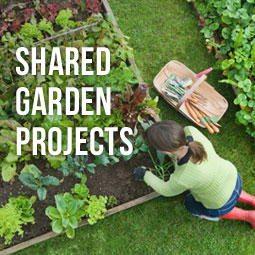 People love designing and working in their gardens for any number of reasons. For many, it’s the connection with the circle of life – watching and helping as seeds morph into beautiful plants that provide visual appeal, sustenance, or both. For others, it’s a practical excuse to get their hands dirty.
People love designing and working in their gardens for any number of reasons. For many, it’s the connection with the circle of life – watching and helping as seeds morph into beautiful plants that provide visual appeal, sustenance, or both. For others, it’s a practical excuse to get their hands dirty.
Shared garden projects add another dimension, bringing folks together to share their love of gardening and reap the collective rewards. Community gardens aren’t anything new. They have been a part of urban landscapes around the US and in other countries for many years. Originally created to give residents of lower income, inner city neighborhoods access to affordable fresh produce, they have grown into a major phenomenon.
In the five years between 2008 and 2013, community garden participation across America tripled. That’s 2 million more households collectively sharing garden projects, according to the National Gardening Association. Now, more than a third of all American households grow at least some of their own food, either in a community garden or at home.
Why shared gardens?
Access to fresh produce may be the bottom line, but it’s fueled by increasing public interest in healthy eating. We want more nutritious food, and we want to know where it’s coming from. Home-grown leaves no questions. DIY veggies are not only the freshest, they cost less than store-bought. We can grow precisely what we like, or try new veggies or herbs to expand our culinary horizons. Local food production also reduces our communal carbon footprint.
But not everyone has land, or enough land, to devote to a vegetable garden. In a typical suburban yard, veggies and/or fruit options might have to share with traditional landscaping, a pool, lawn for the kids to play on, and a separate grassy area for the dog. Downsizing is a growing trend among certain segments of the population, and a lot of people live in apartments or condos with little to no outdoor space.
Community gardens allow everyone to have a veggie garden, and also a place to grow fruit or flowers, if they want. These spaces also serve as learning centers. Veteran “green thumbs” can work side by side with novices, helping them learn as they grow. Kids can learn from parents and eat the results of their lessons. (Planting a veggie garden at home provides the same sharing-with-the kids opportunity.)
In many cities, community gardens serve as the social hub of the neighborhood. People who don’t even have a plot in the garden stop by to chat, eat a carrot or strawberry, or smell the flowers. Some gardens take this a step further and host events such as composting demonstrations or how to choose water-wise plants for home.
It’s all about sustainability and a sense of togetherness
If you’re short on soil space and there’s no community garden nearby, you can team up with one or a few neighbors to grow different veggies and share the wealth as it ripens. It’s the perfect excuse to host a backyard barbecue, complete with a big salad or grilled veggies plucked right from the garden.
And just think – if you’ve installed artificial grass in your yard, you’ll have so much more time to enjoy your group gardening efforts and the social camaraderie that follows. That beats the heck out of slaving over a natural grass lawn week in and week out. Real grass never looks as good as you want it to, it’s expensive, and you can’t even eat it. Who needs that?












